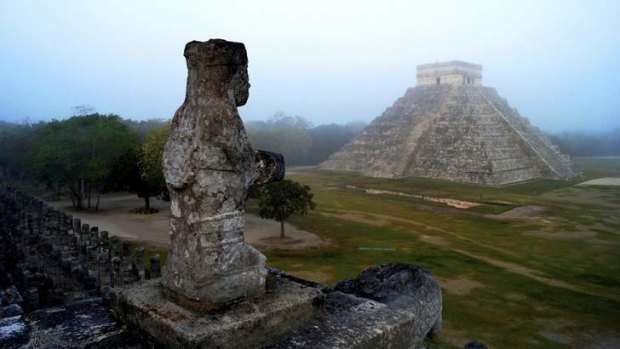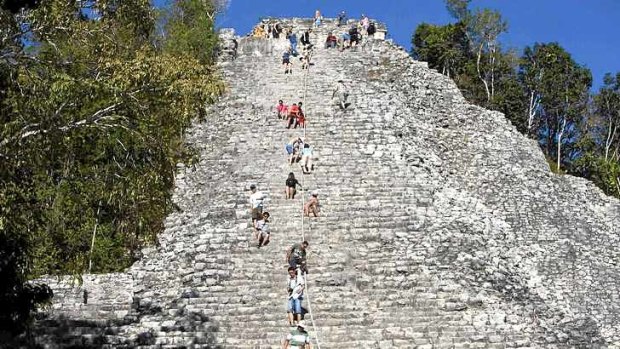
The Maya temple of Kukulkan, the feathered serpent and Mayan snake deity, at the archaeological site of Chichen Itza.Credit: Reuters
A few words by an American scholar, a crumbling Mexican monument and the love of a good yarn were all it took to spawn the belief that the world could end this week.
December 21 marks the end of an age in a 5125 year-old Maya calendar, an event that is variously interpreted as the end of days, the start of a new era or just a good excuse for a party.
Thousands of New Age mystics, spiritual adventurers and canny businessmen are converging on ancient ruins in southern Mexico and Guatemala to find out what will happen.
"No one knows what it will look like on the other side," said Michael Di Martino, 46, a long-haired American who is organizing one of the biggest December 21 celebrations at the Maya temple site of Chichen Itza on the Yucatan peninsula.
It is not the world but "the way we perceive it" that will end, said DiMartino, who pledged his event at ground zero for 2012 acolytes will be a "distilling down of various perspectives into a unified intention for positive transformation, evolution and co-creation of a new way of being."
A mash-up of academic speculation and existential angst seasoned with elements from several world religions, the 2012 phenomenon has been fueled by Hollywood movies and computer games, and relentlessly disseminated by Internet doom-mongers.

Tourists climb the Maya pyramid of Nohoch Mul at the archaeological site of Coba.Credit: Reuters
Mass hysteria in a Russian prison, a Chinese man building survival pods for doomsday and UFO lovers seeking refuge with aliens in a French mountain village are just some of the reports that have sprung up in the final countdown to December 21.
Robert Bast, a New Zealander living in Melbourne who wrote a book called "Survive 2012" on how to cope with the possible catastrophe, believes the Maya may have sent out a warning.
"The most likely thing for me is a solar storm, but that's not going to kill you straight away. It's more of a long term disaster," said Bast, 47, noting a flu pandemic could also strike the planet. "I feel the world isn't as safe as we think it is. The last couple of generations have had it very cosy."
When dawn breaks on Friday, according to the Maya Long Count calendar, it marks the end of the 13th bak'tun - an epoch lasting some 400 years - and the beginning of the 14th.
This fact would probably have languished in academic obscurity had not a young Maya expert named Michael Coe written in the 1960s that to the ancient Mesoamerican culture the date could herald an "Armageddon" to cleanse humanity.
Since then, the cult of 2012 has snowballed.
Among the sun-bleached pyramids, shaded mangroves and deep cenotes of the Maya heartland, there are hopes December 21 will bring a spiritual re-birth.
Nobody seems quite sure what to expect on Friday, but it has not stopped people getting their hopes up.
"This is the Arab Spring of the spiritual movement," said Geoffrey Ocean Dreyer, a 52-year-old US musician wearing a sombrero and mardi gras beads. "We're going to create world peace. We're going to Jerusalem and we're going to rebuild Solomon's temple."
ANXIETY ATTACKS
The words of Coe, a highly respected Maya scholar, were published in 1966 at the height of the Cold War, stirring fears in a world haunted by the prospect of nuclear holocaust.
Coe could not be reached for comment for this article, but friends and academics who know him insist he never meant to inspire a vision of apocalypse when he committed them to paper.
Stephen Houston, a Maya expert at Brown University in Rhode Island and student of Coe's, said too much has been read into the end of the 13th bak'tun, which was little more than a "dull mathematical declaration" used to bracket dates.
"I see it all as an expression of present day anxiety and not much more than that," Houston said.
Few remaining inscriptions refer to the event, and the best known one is part of a monument recovered from a Maya site in Tabasco state called Tortuguero - much of which was torn down in the 1960s to make way for the construction of a cement factory.
Still, the mix of religion, ancient inscriptions and media-driven speculation about impending doom remains potent.
"I got an email the other day from a mother who was contemplating taking her own life, because she didn't know what was really going to happen, she didn't want her children to live through this ordeal," said David Stuart, a Maya expert at the University of Texas. "We can dismiss it as a kooky idea, which it is, but they're still ideas and they still have power."
US space agency NASA has sought to allay fears of impending catastrophe, noting that "our planet has been getting along just fine for more than 4 billion years, and credible scientists worldwide know of no threat associated with 2012."
Nothing has given the 2012 theories more oxygen in the run-up to the big day than the Internet, noted John Hoopes, a Maya anthropologist at the University of Kansas.
"Computers come straight out of the same people who were smoking pot and protesting at Berkeley and Stanford," he said, referring to US student movements in the 1960s.
"This Maya calendar stuff has been part of hacktivism lore for 40 years, since the beginning, and with every significant change in computer technology, it's gotten another boost."
Many of those gathering in Chichen Itza praised the Internet as a discussion forum and organizing tool for New Age events.
"We don't need leaders now we have the Internet," said Muggy Burton, 66, who had traveled to Mexico from Canada with her 15-year-old, blue-haired granddaughter, Talis Hardy.
The two, who communicate with each other by whistling, plan to live in Mexico for six months, according to Burton, who is going to homeschool Hardy. "It's the end of the world for her, and the beginning of a new one," she added.
MAYA SKEPTICS
Mexico's federal government is not officially marking the phenomenon, but the country's tourism agency has launched a "Mundo Maya 2012" website with a countdown to December 21.
Up to 200,000 people are expected to descend on Chichen Itza alone for the night of December 20.
Among modern descendants of the Maya, the idea it could all come to an end on Friday generally raises a wry smile - but they are happy to play along if it makes money.
"It's a psychic epidemic," said Miguel Coral, 56, a cigar salesman in Merida, a colonial town and capital of Yucatan state. "It's all about business, but that's fine. It helps our country. I think it's excellent we've exported this idea."
Nearby, workers built a pyramid of spray-painted polystyrene blocks for the opening of the town's Maya festival.
"If people who believe in this joke want to come, let them," said Jose May, a Merida tourism official of Maya descent. "Nobody here believes that. Those people were sold an idea."
Hazy rumors have helped feed the sense of anticipation.
A few hours' drive south of Merida in the remote Maya town of Xul, which means "the end," media reports began circulating as early as 2008 that a group of Italians were readying themselves for impending doom by building apocalypse-proof bunkers.
Today, the settlement dubbed the "end of the world resort" is open for business as "Eco Spa Las Aguilas."
"There's no truth in it," said deputy manager Andrea Podesta, 45, referring to speculation it was a cult.
"Some people came here, took some hidden photos, and published some very unpleasant articles about us," he added, noting the glistening new spa was booked up well into 2013.
Inside, a group of elderly Italians, mostly dressed in white, were watching the path of an asteroid on a giant screen. A black-and-white image of Christ's face hung from the wall and a large stone statue of a robed woman greeted visitors.
Whatever lies in store for the planet, even Maya academics who have fought to play down the hype surrounding the passing of another 24 hours feel there could still be some surprises.
"I think there may be some mischief on December 21 because the whole world is watching," said Hoopes in Kansas, citing rumors hacktivist group Anonymous was planning a stunt. "It's a very fertile opportunity for a tremendous prank."
Reuters
Sign up for the Traveller Deals newsletter
Get exclusive travel deals delivered straight to your inbox. Sign up now.